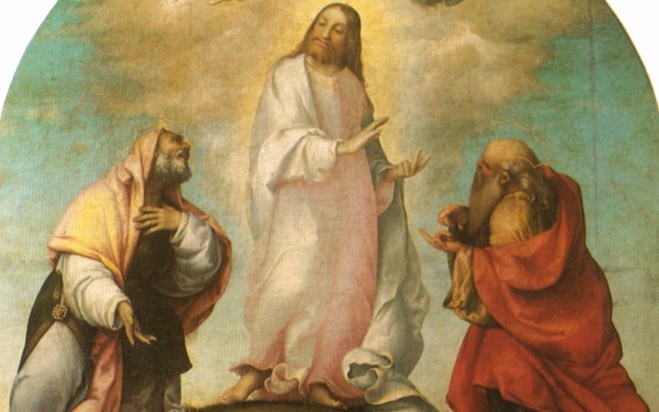|
Detail of The Transfiguration of Christ by Lorenzo Lotto, c. 1511, via Wikimedia Common August 6
Note that the event of Jesus’ transfiguration begins with him in prayer. How could it be any other way? The whole experience in Luke’s account is bracketed by Jesus pointing toward the way of the cross and his eventual death. He enters into prayer as he offers himself to a centered conversation with God whereby he might gain clarity about his mission on earth. Jesus’ “departure,” or even better, “exodus,” which he is to accomplish at Jerusalem, signifies his unique role in salvation history. The way of Jesus, the way of giving oneself away as an offering of love and in thanksgiving for the gift of life, is the way for all. The Transfiguration gives us a window through which we are able to catch a glimpse of Jesus’ identity continuing in the fullness of the Law and the Prophets as known through Moses and Elijah. We are also given a view, as the veil is pulled back a bit, of the purpose of all humanity. There are gifted moments in life when we are able to see most clearly, unitive experiences if you will, when we know to the very depths of our being why we are here, for what we were created, and that in our human experience we know ourselves held by a love that knows no bounds. I had such an experience in a systematic theology class when my professor shared with us a particularly sacred and tender moment in his life. While out to dinner with his wife, he got a phone call to return home immediately where a baby sitter had been caring for his young child. They learned that in a horrific accident in the home and through no fault of the baby sitter, their beloved child had died. These words from my professor were indelibly marked on my soul that day when he said, “I have been to the bottom and the bottom is firm.” It is firm because of the One who holds us and just as with Jesus, calls us beloved. It is something of the quality of that awareness that Jesus knew on the holy mount. He was completely and transparently in that moment so drawn by grace into the fullness of his humanity that his divinity could not help but become evident as well. This is why in the end, in Christian understanding, there is really only one sacrament, who is Jesus the Christ. He is the outward and visible sign of the inward and spiritual grace of God. Any other sacramental expression is only so to the degree that it manifests Christ himself and as it draws us to the place where we know our own Christ-likeness. One of my spiritual practices is to look for how a person has been a sacrament in his or her life, a window through which we catch a glimpse of the beauty of God and that to which Jesus points. This often plays out when I am reflecting on a life in preparation to preach at a funeral. A dear friend died recently. When pondering his gift to me, I realized that in his presence and his own broken humanity, I always knew I was loved. In this way he portrayed Christ to me – no question. This is God’s gift to Jesus in his transfiguration. It is God’s gift to us in Christ. It is to be our gift to the world. Bishop Skip Comments are closed.
|
Bishop Skip AdamsThe Right Reverend Gladstone B. Adams III was elected and invested as our Bishop on September 10, 2016. Read more about him here. Archives
December 2019
Categories |
Copyright © 2024 The Diocese of South Carolina
P.O. Box 20485, Charleston, SC 29413 - 843.259.2016 - [email protected]
P.O. Box 20485, Charleston, SC 29413 - 843.259.2016 - [email protected]


 RSS Feed
RSS Feed